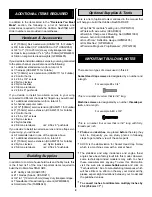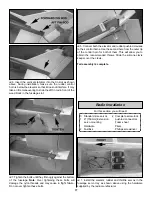
1. Your Hobbico NexSTAR ARF should not be considered a
toy, but rather a sophisticated, working model that functions
very much like a full-size airplane. Because of its
performance capabilities, the Hobbico NexSTAR ARF, if not
assembled and operated correctly, could possibly cause
injury to yourself or spectators and damage to property.
2.
You must assemble the model according to the
instructions. Do not alter or modify the model, as doing so
may result in an unsafe or unflyable model. In a few cases
the instructions may differ slightly from the photos. In those
instances the written instructions should be considered as
correct.
3. You must take time to build straight, true and strong.
4. You must use an R/C radio system that is in first-class
condition, and a correctly sized engine and components
(fuel tank, wheels, etc.) throughout the building process.
5. You must correctly install all R/C and other components
so that the model operates correctly on the ground and in
the air.
6. You must check the operation of the model before every
flight to insure that all equipment is operating and that the
model has remained structurally sound. Be sure to check
clevises or other connectors often and replace them if they
show any signs of wear or fatigue.
7. If you are not an experienced pilot or have not flown this
type of model before, we recommend that you get the
assistance of an experienced pilot in your R/C club for your
first flights. If you’re not a member of a club, your local hobby
shop has information about clubs in your area whose
membership includes experienced pilots.
Remember: Take your time and follow the instructions to
end up with a well-built model that is straight and true.
This is a partial list of items required to finish the Hobbico
NexSTAR ARF that may require planning or decision
making before starting to build. Order numbers are provided
in parentheses.
There are four different ways you can set up your NexSTAR.
The “standard,” most economical setup would be to use four
servos - three servos in the fuselage (for the throttle, rudder
and elevator) and one servo in the wing for the ailerons. This
requires only a standard, 4-channel radio. The second
option would be to use two servos in the wing (one for each
aileron). Using two aileron servos will increase the roll rate
(for when you are ready to graduate to slightly more
advanced aerobatics). This option will require a Y-harness to
connect the servos, but a standard 4-channel radio may still
be used. The third option would be to “mix” the two aileron
servos electronically so the ailerons can be operated as
both ailerons and flaps (flaperons). Doubling the ailerons as
flaps adds another dimension to your flying regimen as you
will be able to execute super-slow landings and flight. The
use of flaperons will require a minimum 5-channel computer
radio for mixing the servos electronically. The fifth option is
for those who have a 5-channel, non-computer radio, but
still desire functional flaps. This will require a sixth servo to
operate the flaps separately. Instructions are provided on
how to cut the ailerons so the inboard portion can be
operated as flaps. All of these options may be done with
standard servos and the regular 500mAh-600mAh battery
pack that came with your radio (special servos or a larger
battery pack are not required).
The recommended engine size range for the Hobbico
NexSTAR ARF is .46 to .50 two-stroke or .52 to .56 four-stroke.
If an engine in the upper end of the size range is used,
remember that this is a model that is intended to fly at scale-
like speeds, so throttle management should be practiced. Any
engine in the lower range will be able to fly this model with
authority. Therefore, the engines in the high range are only
recommended for modelers who fly at high altitude.
Engine Recommendations
Radio Equipment
DECISIONS YOU MUST MAKE
NOTE: We, as the kit manufacturer, provide you with a top quality
kit and great instructions, but ultimately the quality of your
finished model depends on how you build it; therefore, we cannot
in any way guarantee the performance of your completed model,
and no representations are expressed or implied as to the
performance or safety of your completed model.
PROTECT YOUR MODEL,YOURSELF
& OTHERS...FOLLOW THESE
IMPORTANT SAFETY PRECAUTIONS
3
Summary of Contents for NexStar ARF
Page 31: ...31 Correct Angle Rods Fin...
Page 32: ...32...


















